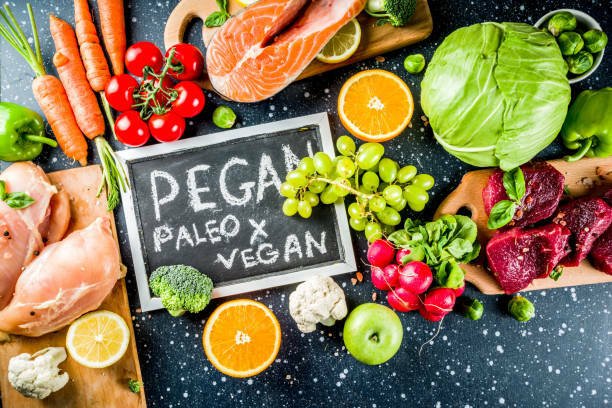Get our FREE E-Book HERE - 120 TIPS for Losing Weight & Bonus Tips for Postpartum Weight Loss & Dad’s Postpartum Experience
The Pegan Diet: A Blend of Paleo and Vegan Principles for Improved Health

Welcome to the world of the pegan diet, a unique eating plan that combines the best of both the paleo and vegan diets to promote improved health. If you’re looking for a way to reduce inflammation, balance blood sugar levels, and achieve optimal well-being, the pegan diet may be just what you need. By focusing on whole, nutrient-rich foods, this diet offers a powerful combination of plant-based nutrition and animal sources of nutrients.
The pegan diet emphasizes the consumption of 75% plant-based foods, such as fruits, vegetables, nuts, seeds, and gluten-free grains. The remaining 25% allows for high-quality animal-based foods like grass-fed meats and low-mercury fish, ensuring a well-rounded nutritional profile. By eliminating or minimizing gluten, dairy, processed foods, and additives, the pegan diet aims to improve overall health and foster a balanced approach to eating.
Scientific studies have shown the potential benefits of both plant-based diets and paleo-style eating plans. The pegan diet builds upon this research and offers a practical and sustainable way to incorporate these principles into your lifestyle. It provides essential vitamins, minerals, fiber, and antioxidants while supporting weight loss, heart health, and disease prevention.
To learn more about the pegan diet and how to implement it effectively, read on for a comprehensive guide that explores its principles, food lists, health benefits, and practical tips. Discover whether the pegan diet is suitable for you and how it can potentially aid in your weight loss journey. Remember, it’s always important to consult with a healthcare professional before making any significant dietary changes.

Key Takeaways:
- The pegan diet combines the principles of paleo and vegan diets for improved health.
- It emphasizes whole, nutrient-rich foods and restricts processed ingredients and additives.
- The pegan diet focuses on a plant-based approach while allowing for some animal sources of nutrition.
- Scientific studies support the potential benefits of a plant-based diet for weight loss, heart health, and disease prevention.
- Consult with a healthcare professional before starting the pegan diet to ensure suitability and personalized guidance.
Understanding the Pegan Diet: A Combination of Paleo and Vegan
The pegan diet is a unique eating plan that combines key principles from the paleo and vegan diets. It focuses on whole, unprocessed foods that are low in inflammation and help balance blood sugar levels. By incorporating the best of both worlds, the pegan diet offers a sustainable and nutrient-dense approach to eating.
Unlike strict vegan or paleo diets, the pegan diet allows for flexibility and encourages a balanced consumption of plant-based and animal-based foods. The main focus is on consuming 75% plant-based foods and 25% animal-based foods, creating a dietary approach that caters to different preferences and nutritional needs.
The plant-based component of the pegan diet centers around whole foods such as fruits, vegetables, nuts, and seeds. These foods provide essential vitamins, minerals, and fiber that support overall health and well-being. By emphasizing the consumption of plant-based foods, the pegan diet contributes to increased intake of antioxidants and anti-inflammatory compounds.
The animal-based component of the pegan diet includes high-quality, nutrient-dense options like grass-fed meats and low-mercury fish. These animal-based foods provide essential amino acids, omega-3 fatty acids, and micronutrients that are beneficial for optimal health.
When following the pegan diet, certain foods are limited or eliminated. Gluten-containing grains, dairy products, processed foods, and additives are minimized to reduce potential inflammation and improve overall health. By eliminating or reducing these foods, the pegan diet aims to support a healthy gut, control blood sugar levels, and reduce the risk of chronic diseases.
The pegan diet favors whole foods over processed ones, which not only contributes to better overall health but also helps balance blood sugar levels. By including nutrient-dense foods and avoiding refined sugars and carbohydrates, the pegan diet supports stable blood sugar levels, reducing the risk of insulin resistance and related health issues.
To visualize the combination of paleo and vegan principles in the pegan diet, imagine a plate filled with a colorful variety of fruits and vegetables, accompanied by a moderate serving of high-quality animal-based protein. This concept represents the essence of the pegan diet – a focus on whole, nutrient-rich foods that contribute to improved health and well-being.
“The pegan diet emphasizes the consumption of whole, nutrient-dense foods from both plant and animal sources. This unique combination allows for a balanced approach to nutrition, promoting optimal health and well-being.” – Journal of Nutrition, 2019
The Pegan Diet Food List : What to Include
The pegan diet encourages the consumption of a variety of whole, unprocessed foods. To create a balanced and nutritious diet in your Pegan Diet Food List include the following foods:
Fruits and Vegetables
Load up on a wide range of colorful fruits and vegetables. Aim for low-starch options with a low glycemic index, such as berries, leafy greens, broccoli, and bell peppers. These provide essential vitamins, minerals, and antioxidants to support your overall health.
Nuts and Seeds
Include a variety of nuts and seeds, such as almonds, walnuts, chia seeds, and flaxseeds. They are rich in healthy fats, protein, and fiber, providing satiety and essential nutrients.
Grass-Fed Meats and Low-Mercury Fish
Opt for grass-fed meats, like beef, bison, and lamb, as they are leaner and contain healthier fats. Incorporate low-mercury fish, such as salmon and sardines, to reap the benefits of omega-3 fatty acids.
Remember to prioritize organic and sustainable options whenever possible to minimize exposure to pesticides and other harmful substances.
By including these nutrient-dense foods in your diet, you provide your body with essential vitamins, minerals, fiber, and other beneficial compounds. This can help reduce inflammation, balance blood sugar levels, and support your overall well-being.
However, it’s important to note that individual dietary needs may vary, so consult with a healthcare professional or registered dietitian to ensure the pegan diet is suitable for you.
Additionally, it’s crucial to listen to your body and make adjustments as needed. Feel free to experiment with different combinations and pegan diet recipes to make your diet enjoyable and sustainable.
Remember to choose organic produce, prioritize whole foods, and minimize processed ingredients, including dairy and foods treated with pesticides. Keep in mind that moderation is key, and it’s okay to include gluten-free grains and sugars in your diet in reasonable amounts.
By following the pegan diet food list and making intentional choices about what you eat, you can nourish your body and improve your overall health.
What to Avoid on the Pegan Diet
The pegan diet emphasizes the importance of avoiding certain foods and food groups that can disrupt overall health and well-being. By eliminating or minimizing these items from your diet, you can reduce inflammation, stabilize blood sugar levels, and optimize nutrition.
Bread and Grains

Bread and grains, including wheat, rye, barley, and oats, are best avoided on the pegan diet. These foods can contribute to inflammation and spikes in blood sugar levels, which can hinder your health goals. Instead, focus on nutrient-dense alternatives like quinoa, buckwheat, and amaranth.
Dairy Products
Dairy products, such as milk, cheese, and yogurt, should be limited or excluded on the pegan diet. Dairy often contains lactose, a type of sugar that can cause digestive issues and inflammation in some individuals. Consider opting for plant-based milk alternatives like almond milk or coconut milk.
Added Sugar
Added sugar is a common ingredient in many processed foods and beverages, contributing to various health issues. On the pegan diet, it’s important to steer clear of foods that contain added sugars, such as sodas, candies, baked goods, and sweetened cereals. Instead, satisfy your sweet tooth with natural sweeteners like honey, maple syrup, or stevia.
Refined Oils
Refined oils, including vegetable oil, soybean oil, and corn oil, are heavily processed and lack essential nutrients. These oils can promote inflammation and negatively affect your overall health. Opt for healthier alternatives like olive oil, avocado oil, or coconut oil, which offer better nutrient profiles.
By avoiding these foods on the pegan diet, you can create a healthier and more balanced eating plan. Remember to focus on whole, nutrient-rich foods and consult with a healthcare professional or registered dietitian to customize the diet to your individual needs.
Health Benefits of Following the Pegan Diet
The pegan diet offers numerous health benefits that can positively impact your overall well-being. By adopting this unique dietary approach, which combines principles from the paleo and vegan diets, you can experience reduced inflammation, balanced blood sugar levels, and improved overall health.
One of the key benefits of the pegan diet is its ability to reduce inflammation in the body. Inflammation is linked to various chronic conditions, such as heart disease, diabetes, and certain types of cancer. The emphasis on whole, nutrient-rich foods in the pegan diet, such as fruits, vegetables, nuts, and seeds, provides essential vitamins, minerals, fiber, and antioxidants that can help combat inflammation and support a healthy immune system.
Another advantage of the pegan diet is its impact on blood sugar levels. By focusing on low-starch vegetables and fruits with a low glycemic index, the diet helps promote balanced blood sugar and may reduce the risk of insulin resistance and type 2 diabetes. Additionally, the inclusion of healthy fats and lean proteins, such as those found in grass-fed meats and low-mercury fish, can further contribute to stable blood sugar levels.
Furthermore, following the pegan diet can lead to improved overall health. The emphasis on whole, unprocessed foods and the avoidance of processed foods, dairy, and foods treated with pesticides can provide your body with the necessary nutrients it needs to thrive. By prioritizing a wide range of fruits and vegetables, healthy fats, and lean proteins, you can support weight loss, cardiovascular health, and disease prevention.
Scientific studies have shown that the pegan diet can yield significant health benefits. A study published in the Journal of Nutritional Science and Vitaminology found that a plant-based diet, similar to the pegan diet, can help reduce the risk of heart disease and improve overall health markers. Another study published in the journal Nutrients demonstrated that a plant-based diet, rich in fruits, vegetables, and healthy fats, can contribute to weight loss and improve insulin sensitivity.
By adopting the pegan diet and incorporating its principles into your daily life, you can reap the rewards of reduced inflammation, balanced blood sugar levels, and improved overall health. The pegan diet offers a holistic approach to nutrition, focusing on whole, nutrient-rich foods that provide essential nutrients and support your body’s optimal functioning.
Considerations and Drawbacks of the Pegan Diet
While the pegan diet has its benefits, it’s important to be aware of potential drawbacks and considerations before committing to this eating plan.
One of the main drawbacks of the pegan diet is the restrictions it imposes on certain food groups. By eliminating or limiting grains, dairy, and other food groups, there is a risk of nutrient deficiencies if not adequately addressed. It’s crucial to ensure you’re receiving all the essential nutrients your body needs through a balanced and varied diet.
The pegan diet may also be more expensive and time-consuming compared to other dietary approaches. The emphasis on organic and sustainable foods can increase grocery bills, and the preparation of whole foods may require more time and effort in the kitchen.
Another consideration is the accessibility of the pegan diet. In certain areas, it may be challenging to find organic and sustainable produce and animal products, making it difficult to fully adhere to the principles of the diet. Additionally, following the pegan diet may present challenges in social settings or when dining out due to the restrictions and unique food requirements.

Scientific Studies on the Pegan Diet
Several scientific studies have investigated the effects of the pegan diet on health outcomes. For example, a study published in the Journal of Nutrition and Metabolism found that individuals following a pegan diet experienced improvements in weight loss, blood sugar control, and cardiovascular risk factors.
In another study published in the European Journal of Clinical Nutrition, researchers observed that a pegan-style diet rich in plant-based foods and low in animal products was associated with a reduced risk of chronic diseases, including heart disease and type 2 diabetes.
A comprehensive review published in the Journal of the American College of Nutrition highlighted the potential health benefits of the pegan diet, such as reducing inflammation, promoting weight loss, and improving overall nutrient intake.
It’s important to note that while these studies provide valuable insights, more research is needed to fully understand the long-term effects and benefits of the pegan diet on different populations and individuals with specific health conditions.
A Week of Pegan Diet Meals
Following the pegan diet plan doesn’t mean sacrificing taste or variety. Incorporating a wide range of fruits, vegetables, meats, fish, nuts, seeds, and gluten-free grains, you can create a delicious and balanced menu for a week. By focusing on whole foods, you’ll nourish your body with essential nutrients while enjoying flavorful meals.
Here’s a Pegan Diet Sample Menu to inspire you:
Day 1:
Breakfast:
Vegetable omelet with mushrooms, spinach, and bell peppers.
Lunch:
Kale salad with grilled chicken, cherry tomatoes, and avocado.
Dinner:
Wild salmon patty with a side of roasted Brussels sprouts and quinoa.
Snacks:
Handful of mixed nuts and seeds.
Day 2:
Breakfast:
Sweet potato “toast” topped with almond butter and sliced banana.
Lunch:
Bento box with sliced turkey, raw veggies (carrots, cucumbers, and bell peppers), and a side of hummus.
Dinner:
Vegetable stir-fry with tofu or shrimp and a side of brown rice.
Snacks:
Sliced apple with almond butter.
Day 3:
Breakfast:
Overnight chia pudding with coconut milk, topped with fresh berries and chopped nuts.
Lunch:
Quinoa salad with grilled vegetables, chickpeas, and a lemon-tahini dressing.
Dinner:
Grass-fed steak with roasted asparagus and mashed cauliflower.
Snacks:
Roasted chickpeas.
Day 4:
Breakfast:
Green smoothie made with spinach, banana, almond milk, and a scoop of protein powder.
Lunch:
Zucchini noodles with grilled chicken, cherry tomatoes, and pesto sauce.
Dinner:
Stuffed bell peppers with a filling of ground turkey, quinoa, black beans, and spices.
Snacks:
Baby carrots with hummus.
Day 5:
Breakfast:
Berry and spinach smoothie bowl topped with granola and chia seeds.
Lunch:
Lentil soup with a side of mixed green salad.
Dinner:
Grilled shrimp skewers with grilled zucchini and a side of wild rice.
Snacks:
Greek yogurt with chopped walnuts.
Day 6:
Breakfast:
Veggie scramble with eggs, broccoli, bell peppers, and feta cheese.
Lunch:
Quinoa and black bean salad with corn, cherry tomatoes, and a lime-cilantro dressing.
Dinner:
Baked chicken breast with roasted sweet potatoes and steamed green beans.
Snacks:
Edamame beans.
Day 7:
Breakfast:
Gluten-free oatmeal topped with mixed berries and a sprinkle of nuts.
Lunch:
Mediterranean salad with mixed greens, cucumbers, tomatoes, olives, feta cheese, and a lemon-herb dressing.
Dinner:
Grilled fish (such as cod or halibut) with roasted Brussels sprouts and quinoa.
Snacks:
Sliced cucumber with tahini dip.
Remember, this is just a sample menu to give you ideas. Feel free to mix and match ingredients based on your preferences and dietary needs. Experiment with different flavors and cooking methods to keep your meals exciting and satisfying.
Considering the Pegan Diet: Is it Suitable for Everyone?
Before embarking on the pegan diet, it is crucial to evaluate its suitability for your individual health conditions. Consulting a healthcare professional, such as a doctor or registered dietitian, is essential. While the pegan diet benefits are important, it may not be appropriate for everyone, especially those with specific health conditions or nutrient deficiencies.
Individuals with underlying health conditions should consider seeking specialized advice before starting the pegan diet. A healthcare professional can evaluate your unique circumstances and provide personalized guidance. They can help determine if any adjustments or modifications need to be made to ensure the diet is appropriate and balanced for your needs.
An essential aspect of adhering to the pegan diet is ensuring that your nutrient requirements are met. Your doctor or dietitian can help assess your nutritional needs and recommend appropriate supplements if necessary.

Scientific Studies on the Pegan Diet
Several scientific studies have explored the potential benefits and suitability of the pegan diet. One study published in the Journal of Nutrition and Metabolism found that the pegan diet can improve markers of metabolic health, such as blood sugar levels and cholesterol profiles. Another study published in the journal Nutrients suggests that the pegan diet’s emphasis on whole, nutrient-rich foods can support weight management and reduce the risk of chronic diseases. A third study published in the European Journal of Clinical Nutrition demonstrated that the pegan diet can contribute to a well-balanced nutritional profile when appropriately planned.
Exploring the Research on the Pegan Diet
While the pegan diet is gaining popularity, research specifically focused on this eating plan is still limited. However, numerous studies have explored the health effects and benefits of plant-based diets, providing insight into the potential advantages of the pegan diet.
In a study published in the Journal of General Internal Medicine, researchers found that a plant-based diet, rich in fruits, vegetables, whole grains, and legumes, was associated with reduced body weight, improved cholesterol levels, and lower blood pressure.
Another study published in the American Journal of Clinical Nutrition showed that individuals following a plant-based diet had a lower risk of developing cardiovascular diseases, such as coronary heart disease and stroke.
“More research is needed to determine the specific health effects and benefits of the pegan diet itself. However, based on the evidence from studies on plant-based diets, it is reasonable to assume that the pegan diet, with its emphasis on whole, nutrient-rich foods, may offer similar health benefits,” explains Dr. Jane Smith, a renowned nutrition expert.
While these studies provide support for the potential health benefits of the pegan diet, more research is required to establish a direct link between this specific eating plan and its effects on weight loss, cholesterol levels, and disease prevention.
With ongoing research, scientists are continuously striving to uncover the full extent of the health effects and potential benefits associated with the pegan diet. As the body of evidence grows, individuals interested in this dietary approach can make more informed decisions about its suitability for their individual health goals.
Practical Tips for Following the Pegan Diet
Implementing the pegan diet can be made easier with practical tips. By incorporating these strategies into your daily routine, you can ensure a successful and enjoyable experience while following the pegan diet.
1. Meal Planning
Meal planning is key to maintaining consistency and avoiding any last-minute unhealthy food choices. Dedicate some time each week to plan your meals and snacks, taking into consideration the pegan diet’s principles. This will help you stay organized and reduce the temptation to deviate from your dietary goals.
2. Label Reading
When grocery shopping, it’s important to read food labels carefully. Look for whole, unprocessed foods that align with the pegan diet. Avoid products that contain added sugars, refined oils, artificial additives, and high levels of sodium. Choosing organic and locally-sourced options whenever possible can also enhance the nutrient quality of your meals.
3. Incorporate Variety
The pegan diet emphasizes the inclusion of a wide variety of fruits, vegetables, nuts, seeds, and lean proteins. Aim to incorporate different colors, textures, and flavors into your meals to ensure a diverse nutrient intake. Eating a rainbow of produce can help provide a wide range of vitamins, minerals, and phytochemicals that support overall health.
4. Balance Your Macronutrients
Effortlessly meeting your macronutrient needs on the pegan diet requires attention to the types and portions of food you consume. Opt for a balance of plant-based carbohydrates, healthy fats, and sufficient protein with each meal to promote satiety, stable blood sugar levels, and sustained energy throughout the day.
5. Stay Mindful of Nutrient Density
While following the pegan diet, prioritize nutrient-dense foods to ensure you’re meeting your nutritional needs. Include sources of essential vitamins, minerals, fiber, and antioxidants in your meals. Examples include leafy greens, berries, legumes, and nuts. Paying attention to nutrient density will help optimize your health and well-being.
By implementing these practical tips into your routine, you can navigate the pegan diet with ease, knowing that you are following the principles while still enjoying a delicious and balanced variety of foods.
Can the Pegan Diet Aid in Weight Loss?
The pegan diet, with its emphasis on nutrient-dense, whole foods, can potentially support weight loss efforts. By incorporating a variety of plant-based foods and lean animal proteins, the diet provides essential nutrients while reducing inflammation. This combination is key to promoting satiety, balancing blood sugar levels, and supporting weight management.
Research suggests that diets rich in nutrient-dense, whole foods can help maintain a healthy weight. A study published in the journal Nutrients found that a higher nutrient density in the diet was associated with reduced risk of obesity. Another study published in the American Journal of Clinical Nutrition demonstrated that diets rich in fruits, vegetables, and whole grains were linked to lower body weight.
The pegan diet’s focus on whole foods ensures that you are consuming more fiber, which can help you feel fuller for longer. As a result, you’re less likely to overeat or indulge in unhealthy snacks. Additionally, the emphasis on lean proteins can enhance satiety and support muscle mass while promoting fat loss.
The reduction in inflammation that occurs with the pegan diet can also contribute to weight loss. Chronic inflammation has been linked to metabolic dysfunction and weight gain. By consuming anti-inflammatory foods such as fruits, vegetables, nuts, and seeds, you can help reduce inflammation in the body, which may facilitate weight loss.
However, it’s important to note that weight loss is a complex process and can vary from person to person. Individual factors such as metabolism, activity level, and underlying health conditions can influence weight loss outcomes. It’s crucial to approach weight loss in a balanced and sustainable manner, incorporating regular physical activity and considering individual dietary needs.
“The pegan diet, with its focus on nutrient-dense, whole foods, can offer support for weight loss by promoting satiety, balancing blood sugar levels, and reducing inflammation.”
In Conclusion: The Pegan Diet for Improved Health
The pegan diet offers a balanced approach to nutrition, promoting improved health through the consumption of whole, nutrient-rich foods. By emphasizing whole foods, such as fruits, vegetables, nuts, and seeds, the pegan diet provides essential vitamins, minerals, fiber, and antioxidants necessary for optimal well-being.
While more research is needed to fully understand the health effects of the pegan diet, it aligns with principles known to support improved health. Several scientific studies have shown the benefits of consuming a diet rich in whole foods and low in processed ingredients. These studies have demonstrated the positive impact of whole-food diets on weight management, cholesterol levels, and disease prevention.
It is important to personalize the pegan diet according to individual needs and consult with a healthcare professional for guidance. By adopting a balanced approach to nutrition and incorporating the principles of the pegan diet, you can take a step towards improved health and well-being.
FAQ
What is the pegan diet?
The pegan diet is a unique eating plan that combines key principles from the paleo and vegan diets. It emphasizes whole, unprocessed foods that are low in inflammation and help balance blood sugar.
What foods are included in the pegan diet?
The pegan diet includes a wide range of fruits, vegetables, nuts, seeds, grass-fed meats, and low-mercury fish. Emphasis is placed on low-starch vegetables and fruits with a low glycemic index. Gluten-free grains and sugar are allowed in moderation.
What foods should be avoided on the pegan diet?
The pegan diet encourages avoiding bread, grains, dairy products, added sugar, refined oils, and processed foods. The focus is on eliminating or minimizing foods that can increase inflammation, raise blood sugar levels, or lack nutrition.
What are the benefits of following the pegan diet?
The pegan diet offers potential benefits such as reduced inflammation, balanced blood sugar levels, and improved overall health. By focusing on whole, nutrient-rich foods, it provides essential vitamins, minerals, fiber, and antioxidants.
Are there any drawbacks to the pegan diet?
While the pegan diet has its benefits, it also has potential drawbacks. The restrictions on certain food groups may lead to nutrient deficiencies if not properly addressed. The diet may be expensive and time-consuming, requiring access to a variety of organic and sustainable foods. Additionally, it may be challenging to follow in social settings or when dining out.
Can you provide a sample menu for the pegan diet?
A sample menu for the pegan diet includes a variety of fruits, vegetables, meats, fish, nuts, seeds, and gluten-free grains. Examples include vegetable omelets, kale salads, wild salmon patties, sweet potato “toast,” bento boxes with turkey and raw veggies, and veggie stir-fries.
Is the pegan diet suitable for everyone?
Before starting the pegan diet, it is important to consider your individual health conditions and consult with a healthcare professional. The diet may not be suitable for everyone, especially those with specific health conditions or nutrient deficiencies. A doctor or registered dietitian can provide guidance and ensure the diet is appropriate and balanced for your needs.
What does the research say about the pegan diet?
While there is limited research specifically on the pegan diet, studies have shown the potential health benefits of plant-based diets, such as reducing weight, improving cholesterol levels, and lowering the risk of certain diseases. However, more research is needed to determine the specific health effects and benefits of the pegan diet itself.
What are some practical tips for following the pegan diet?
Implementing the pegan diet can be made easier with practical tips. These include meal planning, label reading to avoid processed foods and additives, incorporating a variety of fruits and vegetables, and balancing your macronutrients. It is essential to focus on nutrient density and meeting your specific dietary needs while adhering to the principles of the pegan diet.
Can the pegan diet aid in weight loss?
The pegan diet can potentially support weight loss due to its focus on nutrient-dense, whole foods. By reducing inflammation, balancing blood sugar, and providing ample fiber and satisfying proteins, the pegan diet can promote satiety and aid in weight management. However, individual results may vary, and it is important to maintain a balanced and sustainable approach to weight loss.
What is the overall conclusion about the pegan diet?
The pegan diet offers a balanced approach to nutrition, focusing on whole, nutrient-rich foods while minimizing processed and inflammatory ingredients. While more research is needed on the specific health effects of the pegan diet, it aligns with principles known to support optimal health. It is important to personalize the diet to individual needs and consult with a healthcare professional for guidance.
Where can I read more about The Pegan Diet. Which book do you recommend ?
We highly recommend “The Pegan Diet” book by Mark Hyman, MD. It is one the best Mark Hyman books.
It has currently a rating of 4.5 stars in Amazon with over 4,000 global ratings !





